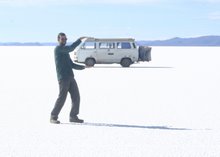
Beulah arrived the next day, quite early in the morning. We picked her up at the airport, then got her settled into the one small room at Quinta Lala (usually reserved for campers rained out of their tents).
We went first to Sacsayhuayman (it sounds a little like sexy woman), the Inca ruins that are right next door to our camp spot. They are built on a ridge that overlooks the city of Cuzco, and the stones used in the construction are absolutely gargantuan. It was our first sight of the famous Inca stonework, and it was truly impressive. The largest stone weighs more than 350 tons, and some of the join work defies the imagination – one stone can have as many as 30 angles! These gargantuan stones fit together perfectly, with not even enough room to slide a piece of paper between them.

The Incas were engineers, all right. Their constructions were remarkably earthquake-proof, as well, and have survived a number of large earthquakes that leveled most other nearby buildings. All of the walls have a slight angle, between 8 and 14 degrees, that makes them more stable. They are also built on a foundation of small, round stones, so that when the earthquake hits, the walls can shift on their rolling foundations without collapsing. Amazing.

We had a guide to explain the site to us, and we really enjoyed hearing the extra information. Otherwise it would have just been another beautiful pile of rocks. We wouldn’t have known that Cuzco is built in the shape of a puma, and that Sacsayhuayman is the puma’s head, since it was the ceremonial site. Nor would we have known that the Incas carved their stones with meteorites, and slid them into place on huge leaves of aloe, which then served to help glue the stones together.
The name Saxsayhuaman means satisfied falcon. The site was renamed when the Spaniards slaughtered hundreds of Incas here, and their bodies were left out for the falcons to eat.
After dragging poor Beulah around this pile of rocks (she had come up to 3300m from sea level, and was feeling the altitude) we decided to take a turn around Cuzco and see what we could see. The city is absolutely gorgeous. Tiny river stone streets wind their way in between lovely colonial buildings, some of them with remnants of Inca stonework at the base. The buildings off the central square have elaborately carved wooden balconies. And mountains ring the city, giving you a sense of distance and space whenever you look up from the lovely architecture. Here is a picture of the narrow streets:

It is, of course, VERY touristy, and every time you step into the square you are swarmed by folks trying to sell you finger puppets, postcards, or dinner in their restaurant. Beside the expensive restaurants are stores that sell jewelry and fine alpaca sweaters for hundreds and thousands of U$. But somehow it’s still a nice city.
Another tactic often used to part tourists from their dollars is to dress up in traditional garb, pose with a well-brushed llama or alpaca, and ask for money for taking photos. We took some funny pictures of these two boys with their llamas.

And as we were walking down a central street, looking for coffee and cake, an indigenous woman in full regalia stuffed a baby goat into my arms, and then demanded money for a photo. The goat of course started to poop, and I nearly dropped it. But we got a photo anyhow, and Douglas helped me pick the little balls of goat poop off my clothes afterwards.

After some cake, to revive us, we headed over to a local craft cooperative called the Center for Traditional Textiles of Cuzco. Here they try to preserve the weavers’ art by selling really fine woven goods for fair trade prices, and encouraging children in villages to learn spinning, dyeing, and weaving from their grandparents. In the center of the store, surrounded by the beautiful and varied types of weaving produced by different village traditions, were four weavers using backstrap looms. All the thread is hand-dyed with natural materials, hand-spun with drop spindles, and then woven into intricate patterns. It was incredible to watch – the amount of time needed to produce a single row of weaving was impressive. Here is a video of a weaver at work:
And I can't close this blog entry without mentioning that sweet sweet Beulah brought us the porta potti we've been looking for in every city since Antigua. We are both pleased as punch. Here is a picture of Douglas testing it out:


No comments:
Post a Comment